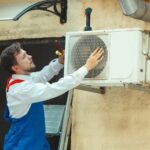Why Is My Furnace Leaking Water?
One of the most common furnace problems is water leaks. A water leak can cause serious damage to your system, and you may end up with a costly repair, or worse you may have to replace your system completely. A leaky furnace can cause water damage and create the ideal condition for mold and mildew growth.
Letting a furnace leak go on without professional servicing can cause serious damage to your system, and home. A furnace repair specialist in Sacramento will need you to answer a few questions to help assess your furnace’s problems. To help you understand the root cause of your furnace’s leak, here are some of the most common causes for a furnace to leak water.
Humidifier Leaks
If you have a humidifier attached to your furnace, a clog or a leak in the humidifier can cause water to drip on your floor. Unaddressed humidifier leaks are a recipe for disaster. A leaky humidifier can cause extensive damage to interior components. It can even damage the floor and walls and cause mold growth.
Some common causes of humidifier leaks include high water pressure, water backup in the drain line and a clogged open valve. Before things take a turn for the worse, have your furnace repair specialist inspect your system.
Condensation Leaks
If you have a high efficiency furnace, it is more likely to generate condensation. Pipes through which the moisture generated by your system escapes can break or become clogged over time causing a condensation leak. A clogged or damaged tubing or a clogged floor drain can also give rise to the problem.
A standard furnace does not usually experience this problem. If you have a standard furnace and the buildup of condensation is still occurring, hire an expert for furnace repair in Sacramento as soon as possible.
Heat Exchanger Problems
Your furnace’s heat exchanger plays an important role in keeping your home warm and comfortable. The primary role of the heat exchanger is to take the heat energy produced during the combustion process and transfer it to indoor air.
Heat exchangers can develop leaks over time. Though rare, this problem can still occur. During maintenance sessions, visually inspect your heat exchanger for leaks. Address problems as soon as you notice them or they may snowball into major concerns.
Heat exchanger repair is one of the most expensive furnace repairs. If you have a damaged heat exchanger, you may have to replace it or your furnace itself. Before you take any decision, have a professional inspect the system. Once the technician acquires an in-depth understanding of the problem, they will help you decide the best course of action.
Dirty and Clogged Filters
Furnace filters are one of the most important parts of furnaces. Unfortunately, they are also one of the most ignored furnace components. A furnace filters traps contaminants such as dust, dirt and debris including pollen and dander, keeping them out of the system.
Over time, filters can become clogged with contaminants. A clogged filter can cause airflow problems and/or cause the furnace to leak water. As the furnace gets stressed, it could overheat and break down.
To prevent performance issues and expensive repairs, change furnace filters every 90 days. Homeowners who have pets, kids or aging adults at home and those with a seasonal allergy will want to replace filters more frequently-ideally every 30 days.
Furnace Leaking Water? Take These Steps to Minimize Damage
If your furnace is leaking water, do not panic! Keep calm and follow these instructions to prevent things from going bad to worse.
- Switch off your furnace – Switching off your furnace will prevent more water from leaking. You can either turn off your furnace from the thermostat or turn off the furnace switch. The furnace switch should be located on your furnace or next to it. If you can’t find it, turn your system off at the breaker
- Clean up water around your unit – Clean up water around your unit with towels and/or napkins. If too much water has leaked, consider using a wet vacuum cleaner
- Clean the water inside your unit – Once the area around your furnace is dry, unscrew the front panel and clean any water that has leaked inside your furnace. This is important as timely action can prevent mold and mildew
- Call a professional – Water can get in hard to reach areas. If you take matters in your own hands, it is highly likely that you will address the symptoms of the problem instead of the problem itself. Instead, call a professional. Sit back and relax or focus on your most important tasks as the technician repairs your furnace
Tips to Prevent Furnace Leaks
When it comes to furnace leaks, prevention is better than cure. Adopt a proactive mindset rather than a reactive approach. Do not wait for your furnace to develop a leak and then address the problem. Follow these tips to take good care of your furnace and prevent leaks in the first place.
- Never trust an amateur for repairs, maintenance, replacement, or new system installation
- Hire a professional to inspect and maintain your furnace annually
- Take care of your furnace. Just because your technician performs maintenance on your furnace every year, does not mean you do not have any responsibility. Periodically change filters, clean the drain, and perform visual inspections to detect potential future problems
South Placer heating and Air is a leading HVAC company in Sacramento. Our pros have years of experience troubleshooting different furnace issues. To make an appointment, call (916) 246-2089.




